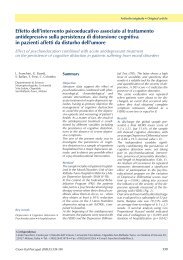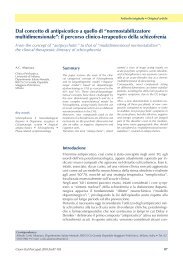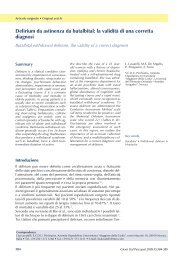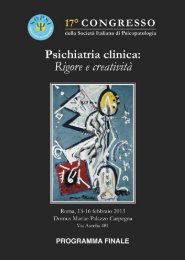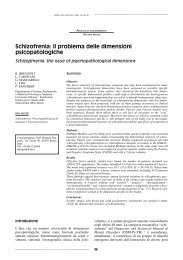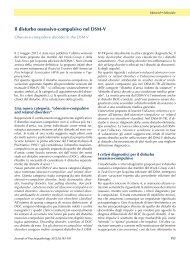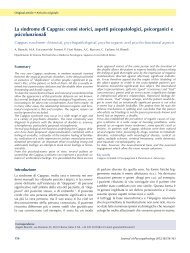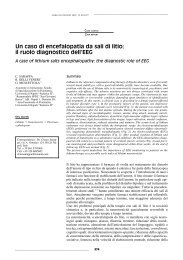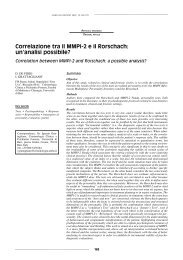XI Congresso della Società Italiana di Psicopatologia Psichiatria ...
XI Congresso della Società Italiana di Psicopatologia Psichiatria ...
XI Congresso della Società Italiana di Psicopatologia Psichiatria ...
You also want an ePaper? Increase the reach of your titles
YUMPU automatically turns print PDFs into web optimized ePapers that Google loves.
SIMPOSI TEMATICI<br />
s’avverte fluire, statu nascentis, la soggettività, il puro desiderio.<br />
L’impossibile e pur necessario pensiero <strong>di</strong> questa “soglia” è<br />
la singolare categoria <strong>della</strong> “paticità”, così come si è venuta<br />
istituendo al centro dei saperi antropologici (filosofia, psicologia,<br />
psichiatria, ecc.) del secolo XX.<br />
Mentre con il concetto <strong>di</strong> “ideologia” si categorizza logicamente<br />
la rappresentazione, non essendovi rappresentazione<br />
che non sia ideologica, manipolata dal desiderio,<br />
con la vaga nozione <strong>di</strong> “paticità” invece si categorizza, solo<br />
ermeneuticamente, il desiderio, nel cercarlo dove non<br />
ancora si è soli<strong>di</strong>ficato in oggetto, né devitalizzato, né integrato<br />
nella rappresentazione che esso stesso con<strong>di</strong>ziona,<br />
bensì fresco sgorga dall’inaccessibile profon<strong>di</strong>tà del magma<br />
emozionale.<br />
La “paticità” allude alla “soglia”, puro sentire, da cui irrompe<br />
la soggettività. È <strong>di</strong> questa l’oscuro e profondo agitarsi che<br />
s’intravede attraverso il “buco” – quel niente chiamato “sé”.<br />
Il patire non è il semplicemente emozionale, ma l’emozio-<br />
nale umanizzato, cioè fatto esistenza, come il più avanzato<br />
sapere psicologico non esita a sostenere.<br />
Certamente tutto ciò riguarda la psicologia e tanto più la psichiatria<br />
nel loro avere a che fare con l’ideologia dal lato <strong>di</strong><br />
ciò <strong>di</strong> cui esse si occupano, ma non dal lato del senso del loro<br />
occuparsene. Tuttavia, solo se si comincia con il comprendere<br />
la curvatura ideologica <strong>di</strong> ciò <strong>di</strong> cui esse si occupano,<br />
i vissuti (concretamente intesi come tensione tra il desiderio<br />
e la rappresentazione, tra il sé e l’io, tra il naturale e<br />
il culturale nell’esistere), si può scoprire se e in quali mo<strong>di</strong><br />
la loro struttura epistemica comporti la criticità necessaria a<br />
un sapere terapeutico del “<strong>di</strong>sagio mentale”. Infatti, se l’origine<br />
del “<strong>di</strong>sagio mentale” sta nel corto-circuito tra la rappresentazione,<br />
che il desiderio strutturalmente (necessariamente)<br />
con<strong>di</strong>ziona, e il desiderio, che l’ideologia congiunturalmente<br />
(non necessariamente) corrompe, è evidente che<br />
la sua terapia non è possibile, qualora la psichiatria non sia<br />
in grado <strong>di</strong> adempiere le con<strong>di</strong>zioni critiche per de-ideologizzare<br />
innanzitutto se stessa.<br />
23 FEBBRAIO 2005 - ORE 16.00-17.30<br />
SALA CAVALIERI 1<br />
S40 - European Bipolar Forum (EBF):<br />
Treating unstable bipolar II. The science and the art<br />
Cyclothymia in Bipolar-II depression<br />
E. Hantouche<br />
Mood Center, Adult Psychiatry Department, Pitié-<br />
Salpêtrière Hospital, Paris<br />
Background: in this report, the author provides an integrative<br />
overview of the place of cyclothymia in mood <strong>di</strong>sorders<br />
and the substantive fin<strong>di</strong>ngs emerging from the<br />
French National stu<strong>di</strong>es: “EPIDEP” and “BIPOLACT –<br />
PSY I/II”.<br />
These stu<strong>di</strong>es were implemented with the aim to facilitate<br />
the clinical recognition of the bipolar spectrum beyond<br />
mania.<br />
It is befitting that such a study be conducted in France,<br />
because it is in this country that a century and a half<br />
ago J. Falret suggested that “Circular Insanity”,<br />
observed in hospitalized patients, was likely to be<br />
prevalent in the community and manifesting in a melancholic<br />
expression with brief moments of happiness,<br />
“moments de gaité”.<br />
Results: related data from EPIDEP demonstrated the importance<br />
of Cyclothymia in further qualifying of Major<br />
Depression to define a <strong>di</strong>stinct, more severe (“darker” BP-<br />
MODERATORI<br />
G. Perugi, F. Benazzi<br />
II 1/2) variant of BP-II. This form of soft bipolarity accounted<br />
for 31% of the total MDE included.<br />
From both clinician- and self-rated scales, 4 items related<br />
to mood, activity and energy regulations were significantly<br />
highly represented in the sub-group with positive family<br />
history of bipolarity. The item “rapid shifts in mood and<br />
energy” obtained the highest relative risk (OR = 3.42) for<br />
positive family history of bipolarity.<br />
The recent “BIPOLACT-PSY” stu<strong>di</strong>es were de<strong>di</strong>cated for<br />
screening hypomania in resistant and recurrent depression.<br />
Respectively 163 and 194 psychiatrists participated,<br />
and selected 630 and 772 patients.<br />
The BP-II rate was 55.4% in resistant depression and<br />
62.5% in recurrent depression. Regression logistic analyses<br />
with adjustment for sensitivity and positive pre<strong>di</strong>ctive<br />
value showed in both stu<strong>di</strong>es that Cyclothymic traits were<br />
the strongest pre<strong>di</strong>ctive factor explaining the presence of<br />
hypomania.<br />
Conclusion: these data add more input on the fundamental<br />
role of cyclothymic temperament in understan<strong>di</strong>ng the<br />
origin and the risk factors of soft bipolarity, especially in<br />
resistant and recurrent depressions.<br />
Similar user-friendly protocols could be applied on a European<br />
level.<br />
102




